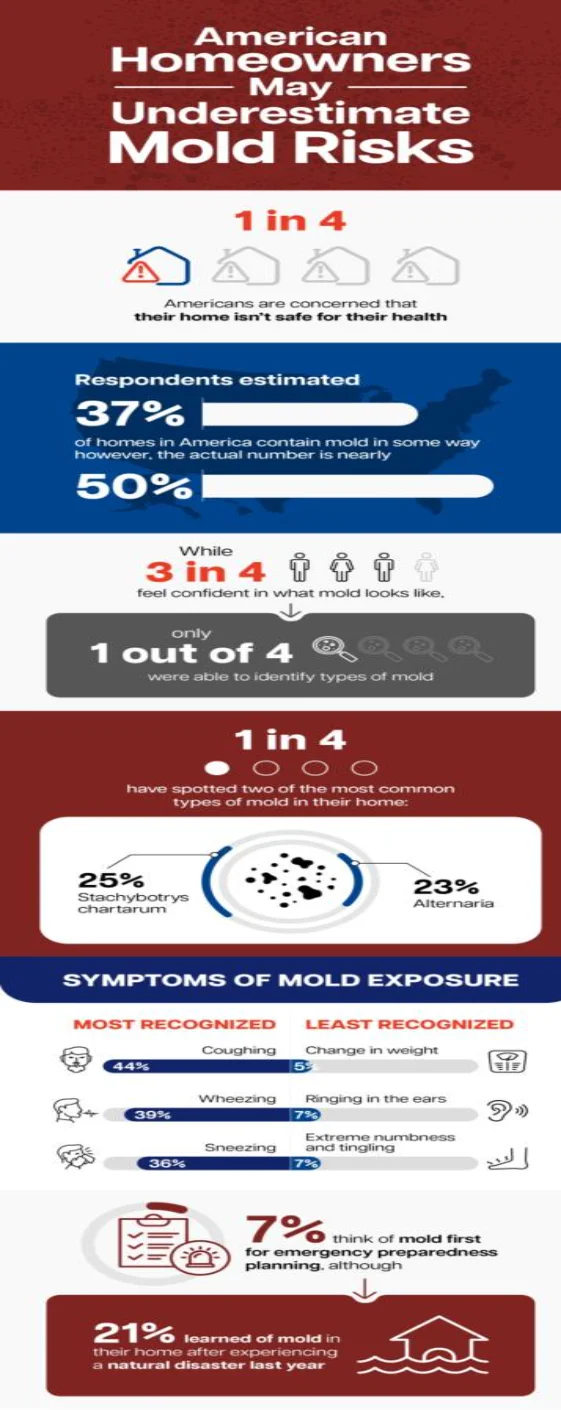
September is National Mold Awareness Month, a key time to learn how to identify mold and understand the health risks it poses.
|
A recent survey reveals that homeowners may underestimate the risk of mold in their homes. While many believe their living conditions are “up to code,” nearly half of all U.S. homes are affected by mold, often without the owners even realizing it.
Key findings from the survey and research include:
- 1 in 4 Americans are concerned their home isn’t safe for their health.
- Homeowners estimate 37% of homes have mold, but the actual number is closer to 47%.
- 3 in 4 homeowners feel confident they could identify mold, yet only 1 in 4 can recognize common types.
- The most common types of mold spotted in homes were Stachybotrys chartarum (25%) and Alternaria (23%).
- Common warning signs include water stains (21%), peeling paint (20%), and musty odors (19%).
- Most recognized symptoms of mold exposure: coughing (44%), wheezing (39%), sneezing (36%).
- Least recognized symptoms of mold exposure: weight changes (5%), ringing in the ears (5%), tingling/numbness (7%).
- Only 7% of homeowners think of mold first when it comes to emergency preparedness — yet 21% discovered mold after a natural disaster last year.

September Is National Mold Awareness Month
Your home is your sanctuary, a place of comfort and safety. But is it protected against this microscopic invader?
Mold is a common and often underestimated problem that can pose significant risks to your property and, more importantly, your health. If you own a residential home or commercial property, it is essential to both understand the dangers of mold and recognize its presence.
Mold Awareness Month is an excellent time to become informed and proactive about protecting your home, family, or business from mold. If you suspect that mold has already taken root, now is the time to schedule professional intervention.
What Is Mold? The Root of the Problem
Mold is a type of fungus that thrives in damp, humid environments. It reproduces by creating tiny, lightweight spores that float through the air and settle on surfaces, where they can begin to grow if moisture is present. From a leaky pipe to a flooded basement, any source of excess moisture can create the perfect breeding ground for mold.
Common types of mold in homes and businesses
While many people think of mold as a green, fuzzy growth, it comes in a vast array of colors and textures. In fact, different types of mold have their own characteristics and potential health risks. Identifying the type of mold on your property is important when considering treatment and remediation.
Some of the most common types include:
- Alternaria: A common mold found indoors and outdoors with airborne spores that commonly cause allergies in humans. It is often dark green, black, or gray, and may grow on drywall, wallpaper, textiles, and wood in damp areas.
- Aspergillus: A very common mold found in homes, often appearing in various colors and textures. Some species of Aspergillus can produce mycotoxins, which are toxic compounds.
- Cladosporium: This mold can be black, green, or brown, and is frequently found on wood surfaces, fabrics, and even in heating and cooling systems. It is a common allergen.
- Stachybotrys chartarum (black mold): Often referred to as “black mold,” this is a greenish-black mold that requires a very wet environment to grow. It is known for producing mycotoxins and is often associated with more severe health effects.
- Penicillium: This mold can appear as blue or green, and is often found on materials with water damage. While some species are used in the production of antibiotics, others can be allergenic or produce mycotoxins.
Understanding the different types of mold is a critical first step in recognizing the potential threat they pose. However, visual identification alone is not enough to determine the full extent of an infestation or the specific health risks involved.
How to Identify Mold: Signs and Symptoms
Early detection is the key to preventing a small mold problem from becoming a major issue. Learning how to identify mold can save you a great deal of time, money, and health-related worries.
Signs of mold exposure in your property
One of the most obvious signs of mold exposure is the presence of a musty, earthy odor. This smell is a tell-tale sign that mold is growing somewhere in your home or business, even if you can't see it. This odor is caused by the release of microbial volatile organic compounds (MVOCs), which are gases produced by the mold.
Visual cues are another important sign of mold exposure. Look for discoloration or patches on walls, ceilings, floors, and personal belongings. Mold can appear in a variety of shades, including black, green, brown, gray, or even white. It might look like fuzzy, slimy, or powdery growth. Pay special attention to areas that have been exposed to water, such as:
- Basements, crawl spaces, and attics
- Around windows, pipes, or faucets
- Behind appliances like refrigerators and washing machines
- Beneath carpeting or wallpaper
- In bathroom grout and caulk
The Health Toll: Effects of Mold Exposure
The effects of mold exposure can range from mild to severe, depending on the individual's sensitivity, the type of mold present, and the duration and level of exposure. While some people may only experience a minor allergic reaction, others, particularly those with pre-existing respiratory conditions like asthma, can suffer more serious consequences.
Symptoms you may experience if mold is in your house
Your own body can also provide clues that there is mold present. Mold spores are potent allergens; when inhaled, they can trigger an allergic reaction in sensitive individuals. Symptoms of mold in the house may include:
- Sneezing, coughing, and a runny nose
- Itchy, watery eyes
- Skin rashes or irritation
- Headaches and fatigue
- Difficulty breathing or wheezing
- Sore throat
Toxic mold compounds
Furthermore, certain types of mold produce mycotoxins, which are toxic compounds that can have a more profound impact on health. Prolonged exposure to mycotoxins has been linked to more severe neurological and respiratory issues.
Chronic effects of mold exposure
The long-term effects of mold exposure can be debilitating. Chronic exposure can lead to persistent respiratory problems, a compromised immune system, and even permanent lung damage.
Since mold can affect the health of everyone living in the home, a musty smell or a few spots of discoloration should never be dismissed as a minor nuisance. Mold is not a problem that can be ignored in hopes that it will go away on its own. It requires immediate and professional attention.
If you or your family members are experiencing these symptoms, especially if you find relief when away from home, mold could be the culprit. Signs of mold exposure should be taken seriously and addressed with a prompt and thorough investigation of your home by a professional.
Why Mold Requires Professional Assistance
Once you have learned how to identify mold and understand the potential threat, your next steps are critical.
Mold cannot simply be scrubbed away
Mold often grows deep into porous materials, meaning that simply scrubbing the surface will not address the root of the problem. Further, disturbing mold without proper containment can release millions of spores into the air, spreading the problem to other parts of your home and increasing the risk of exposure.
Professional mold treatment is necessary
A professional mold treatment service is essential. Certified mold removal professionals understand the science of mold growth and have the specialized equipment and protocols to address it effectively.
A comprehensive mold remediation process will not only remove the visible mold but also locate and eliminate the source of moisture, preventing future growth.
Rainbow Restoration provides thorough mold elimination
Rainbow Restoration® takes a thorough approach to mold, starting with a detailed inspection and containment of the affected area to prevent cross-contamination. Our expert mold professionals will then remove and properly dispose of contaminated materials.
Unlike a quick wipe-down, our trained experts get to the root of the problem, thoroughly sanitize the affected area(s), and inspect for residual effects, such as compromised structural integrity. Rainbow Restoration professionals are trusted nationwide for prompt and effective mold remediation for homes and businesses.
Don’t Take Mold Lightly: Contact Rainbow Restoration
Mold thrives in damp, poorly ventilated areas and can spread quickly if left untreated. It not only damages structures but can also cause serious health problems. DIY solutions are rarely effective. The most effective method of mold removal is working with trained professionals.
If you suspect your home may have signs of mold, call your local Rainbow Restoration for expert mold removal and restoration. Rainbow Restoration offers 24/7 emergency services designed to address your mold problem promptly.
This article is intended for general informational purposes only and may not be applicable to every situation. You are responsible for determining the proper course of action for your home and property. Rainbow Restoration is not responsible for any damages that occur as a result of this blog content or your actions. For the most accurate guidance, call the Rainbow Restoration location nearest you for a comprehensive, on-site assessment.
Mold Awareness Month FAQ
Setting the highest standards in water, fire, and mold damage restoration requires a continuous dedication to education and improvement. This commitment to exceptional service also includes using our years of experience and expertise to answer your restoration questions. Here are answers to some of the most frequently asked questions about mold remediation.
